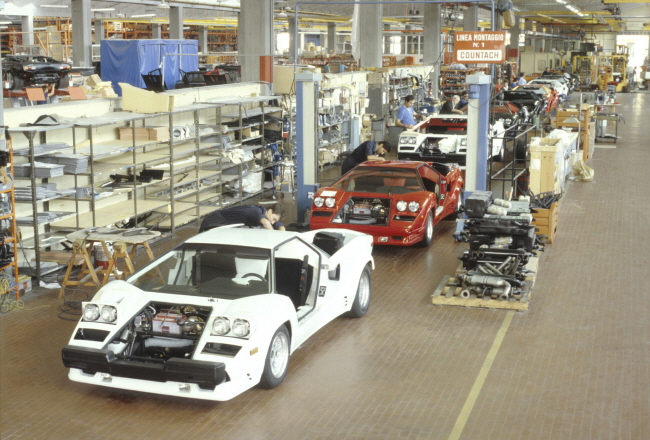
The Lamborghini Countach, a V12 mid-engine supercar, celebrates its 50th anniversary this year. Production began in March 1974 at Lamborghini’s headquarters in Sant’Agata Bolognese, Italy. The Countach is a legendary model that has made a significant mark in supercar history. It was the first Lamborghini to have its body made ‘in-house’, and it was also the first vehicle whose interior was crafted by the Lamborghini Upholstery department. This established a tradition of handcrafting panels and assembling the body, which is regarded as a true innovation.
To commemorate the 50th anniversary, Lamborghini has released exclusive images of the Countach production line, which includes photos taken at the factory where the first Countach LP 400 was born and where the current Lamborghini Revuelto is manufactured.
Raniere Nicoli, Lamborghini’s Chief Manufacturing Officer, stated, “It is a point of pride that we are still producing super sports car models in the place where the Countach was born. Production has fundamentally changed since then, and there has been a clear evolution in many aspects from the Countach production to today’s models. While today’s production is very different from that of 1974, it still boasts the highest quality, combining the artisan skills of our workers with advanced technology to create what we call the ‘Next Level Lamborghini Manufacturing.’ The common denominator between Countach production and today’s Lamborghini vehicles is a profound attention to detail,” he explained.
The Lamborghini Countach LP 500 was showcased as a concept car at the Geneva Motor Show on March 11, 1971, and it achieved immediate success, leading to a swift decision to bring it to mass production. After several prototypes and three years of technical development and rigorous road testing, the production model Countach LP 400 was completed. A production line for the Countach was established in Sant’Agata Bolognese, making it the first innovative method in Lamborghini’s history to fabricate the body in-house. Previously, mechanical components were produced by Lamborghini, while the body was created by external coachbuilders, resulting in a process involving two separate locations for assembly. The decision to manufacture the body internally had a monumental impact on the company’s growth.
The first Lamborghini factory began construction in 1963 and was completed in 1966, covering an area of 12,000 m², coinciding with the start of gearbox and differential production. The factory included production space, offices, testing rooms, and service workshops, with two production lines operating for engine and mechanical components and car assembly. On October 18, 1968, three additional buildings were added, expanding the factory area by 3,500 m². While the current factory spans 346,000 m², the original Countach assembly line remains intact, currently manufacturing the Lamborghini Revuelto, the V12 plug-in hybrid supercar introduced in 2023.
At the small assembly lines where the Countach was produced, all tasks were carried out by hand. The body panels made by pounding on wooden templates were welded and adjusted to fit the body mold. The entire unrefined aluminum body underwent these adjustments before it was combined with the frame and went through several assembly stages on an industrial trolley to be completed. Initially, the interiors were sourced from external suppliers and only fitted and assembled at the factory; however, over time, they gradually took over the entire leather interior decoration and stitching process. This tradition continues today with Lamborghini’s bespoke service, the Ad Personam program.
Today, Lamborghini’s production lines are far more systematic and efficient than in the past, with significant ergonomic improvements. While aluminum was used in the 1970s, carbon fiber is now employed. However, the passion and attention to detail that workers put into new car production remain unchanged.
A total of 1,999 units of the Countach were produced over its 16-year production run, followed by the Diablo, which had 2,903 units produced over 11 years, the Murciélago with 4,000 units over 9 years, and 11,000 units of the Aventador over 11 years. The Countach and the latest model, the Revuelto, share a layout with the V12 engine mounted vertically behind the body. The Revuelto is also equipped with a battery pack, which has shifted the transmission to the rear of the V12 engine. The ‘scissor’ door, a hallmark of Lamborghini V12 vehicles that was first introduced with the Countach, continues to this day. Additionally, the unique visual line that starts from the front fender and extends to the rear spoiler through the cockpit roof, which began with the Countach, has been passed down through the Diablo, Murciélago, and Aventador.
All Countach models throughout history showcase Lamborghini’s evolution with their distinct features and changes. The first Countach LP 400 (1974-1978) saw a production of 152 units and was nicknamed “Periscopio” due to its unique roof design featuring a central groove for the unexpanded fenders and mirrors. The subsequent LP 400 S (1978-1982, 235 units produced) was derived from a special LP 400 commissioned by Lamborghini fan Walter Wolf in Canada. This model featured Pirelli low-profile tires, wide wheel arches, “telephone dial” style wheels, and aerodynamic parts positioned at the front. The 5000 S (1982-1984, 323 units produced) saw the V12 engine’s displacement increase to 4.8L, and the Quattrovalvole (1985-1988, 631 units produced) was visually characterized by a ‘bulge’ in the hood necessary for the 5.2L engine fitted with a 4-valve timing system per cylinder. The Countach 25th Anniversary Edition (1988-1990, 685 units produced) underwent major aerodynamic improvements, altering certain panels such as air intakes on the rear fenders and the hood, and was the first to utilize carbon fiber. The Countach’s success continued for a long time, with the approval for its sale in the US market allowing the last two versions to be produced in the largest numbers.
During its sales period, from the mid-1970s to 1990, the Countach appeared in dozens of films, significantly contributing to the establishment of Lamborghini as a legendary super sports car brand. Even 50 years later, the Countach is remembered as a model representing Lamborghini’s innovation and tradition, and this legacy continues today.
By Lee Sang-jin daedusj@autodiary.kr
